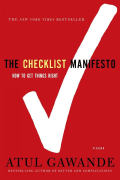My Account
Subscriptions
Summary Categories
Summary Collections
- Career & Life Satisfaction Collection
- Disruptive Innovation Collection
- Exceptional Leadership Collection
- Great Employees Only Collection
- Hidden Gems Collection
- Marketing Collection
- Must-Read Books for 2012 v1
- Must-Read Books for 2012 v2
- Must-Read Books for 2013
- Self-Help Collection
- Small Business Collection
- Strategic Assessment Collection
- Strategic Genius Collection
- Take Charge Collection
- Team Management Collection
- Ultimate Sales Collection
- Web Marketing Collection
Summary List
The Checklist Manifesto:How to Get Things Right
Atul Gawande
Summarized October 2017
Type: [SUMMARY]
SKU: 10171
ISBN: 0805091742
Price: $12.50
Available Formats:






Purchase Summary
Summary Description
From medicine and software engineering to construction and the airline industry, our jobs are becoming increasingly complex. As a result, employees have dozens, and sometimes hundreds, of tasks to do every day. And in many of these, like surgery, missing just one of these tasks can lead to disastrous consequences. How can people possibly keep up?
According to acclaimed surgeon and manager Atul Gawande, all you need is a checklist. In The Checklist Manifesto: How to Get Things Right, he explains how checklists are critical for managing complexity in medicine, business, and other fields. The idea of a checklist is simple, but it has profound implications for high performance, disaster avoidance and team dynamics.
In 2006, Gawande worked with the World Health Organization to find an effective way to reduce preventable errors in the high-stakes world of surgery. With over 25 million surgical procedures performed annually, the complexity of surgery led to errors leaving millions of patients disabled or dead. And many of these mistakes were preventable.
The humble checklist seemed to be a promising answer to this problem, so Gawande began a journey to understand how other industries such as aviation, building construction, and financial investing use checklists to minimize error and increase standards of performance. Through research, trial and error, Gawande discovered that making a checklist is more challenging than it seems. When done incorrectly, checklists can be confusing, frustrating and demotivating. But when done properly, checklists can not only reduce costly errors and save lives, but they also create better teamwork, empower employees, and improve organizational culture.
 Member Log In
Member Log In